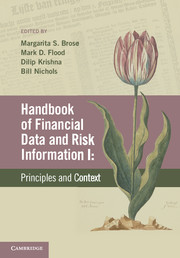Book contents
- Frontmatter
- Contents
- List of contributors
- Preface
- VOLUME I: PRINCIPLES AND CONTEXT
- PART I RISK MANAGEMENT CONTEXT FOR FINANCIAL DATA
- PART II REQUIREMENTS AND SOURCES FOR FINANCIAL RISK MANAGEMENT
- 6 Banking and financial activities in the real economy
- 7 Capital markets data
- 8 Capital markets reference data
- 9 Risk management data and information for improved insight
- PART III REGULATORY DATA
- Index – Volume I
- References
8 - Capital markets reference data
from PART II - REQUIREMENTS AND SOURCES FOR FINANCIAL RISK MANAGEMENT
- Frontmatter
- Contents
- List of contributors
- Preface
- VOLUME I: PRINCIPLES AND CONTEXT
- PART I RISK MANAGEMENT CONTEXT FOR FINANCIAL DATA
- PART II REQUIREMENTS AND SOURCES FOR FINANCIAL RISK MANAGEMENT
- 6 Banking and financial activities in the real economy
- 7 Capital markets data
- 8 Capital markets reference data
- 9 Risk management data and information for improved insight
- PART III REGULATORY DATA
- Index – Volume I
- References
Summary
To seasoned veterans of the market data world, the phrase “capital markets reference data” at first sight may appear somewhat contradictory. Indeed, the notion of the world of “capital markets” brings to mind bright flashing screens displaying prices in real time as transactions occur on the world's securities exchanges or over the counter between firms and investors. In fact, to most professionals in the space, the concept of “reference data” comes as an afterthought (and not usually a pleasant one at that).
Such an assumption is entirely misplaced. Not only do “reference data” contribute significant value to users of capital markets information services, they represent mandatory content required for those services to work. Furthermore, in today's rapidly globalizing economy, it is in the realm of reference data that a significant portion of investment and research is taking place as this is where the opportunities are being uncovered via the development of new trading strategies and improved operations performance.
In Market Data Explained: A Practical Guide to Global Capital Markets Information (Alvarez, 2007a), the general market and reference data landscape is laid out as a logical framework aimed at providing an introductory level of navigation through some relatively complex content. It serves to demonstrate that with a few well thought out fundamental rules, the universe of data content (or at least a significant portion of it) deployed in the capital markets on a daily basis can be classified in a single, coherent structure.
- Type
- Chapter
- Information
- Handbook of Financial Data and Risk Information IPrinciples and Context, pp. 303 - 327Publisher: Cambridge University PressPrint publication year: 2014



